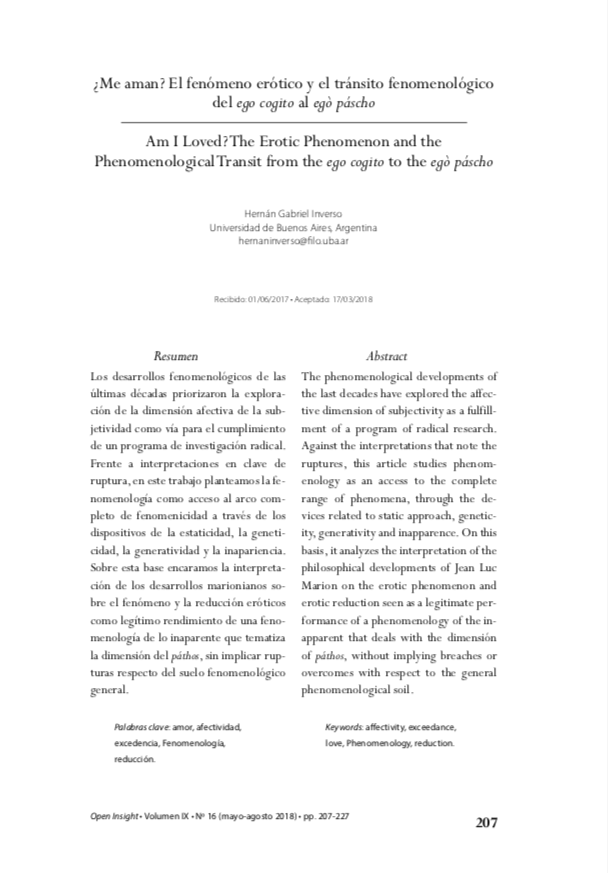Am I Loved? The Erotic Phenomenon and the Phenomenological Transit from the ego cogito to the egò páscho
Abstract
The phenomenological developments of the last decades have explored the affective dimension of subjectivity as a fulfillment of a program of radical research. Against the interpretations that note the ruptures, this article studies phenomenology as an access to the complete range of phenomena, through the devices related to static approach, geneticity, generativity and inapparence. On this basis, it analyzes the interpretation of the philosophical developments of Jean Luc Marion on the erotic phenomenon and erotic reduction seen as a legitimate performance of a phenomenology of the inapparent that deals with the dimensión of páthos, without implying breaches or overcomes with respect to the general phenomenological soil.References
Andersen, P. (1989). “Remarks on the origin of the term ‘passive’”. Lingua 79.1, pp. 1-16.
Andersen, P. (1994). Empirical studies in diathesis. Münster: Nodus.
Casement, W. (1988). “Husserl and the Philosophy of History”. History and Theory 27, 3, pp. 229-240.
Castrillón López, L. (2012). “El poshumanismo del amor: el giro místico de la fenomenología”. Logos, 21, pp. 67-89.
Díaz, D. (2012). “La fenomenología de Jean-Luc Marion: un aporte significativo para el diálogo con la teología revelada”. En C. Arboleda Mora y C. Restrepo, El giro teológico. Medellín: UPB.
Hua: Husserl, E. (1950-2009). Gesammelte Werke-Husserliana I-LX. Dordrecht, Springer (con anterioridad: Den Haag, Martinus Nijhoff; Dordrecht/ Boston/London, Kluwer Academic Publishers).
Inverso, H. (2012). “Las epochaí escéptica y cirenaica consideradas desde la tradición fenomenológica”. La lámpara de Diógenes 13, pp. 29-41.
Inverso, H. (2013). “De E. Husserl a J.-L. Marion: donación y límites de la fenomenología”. Franciscanum 159, pp. 127-154.
Inverso, H. (2015). El mundo entre paréntesis. Una arqueología de las nociones de reducción y corporalidad. Buenos Aires: Prometeo.
Inverso, H. (2016). “La fenomenología de lo inaparente y el problema de las vías hacia el plano trascendental”. Eidos 26, pp. 43-73.
Inverso, H. (2018). Fenomenología de lo inaparente. Buenos Aires: Prometeo.
Marion, J.-L. (1989). Réduction et donation. Recherches sur Husserl, Heidegger et la phénoménologie (= RD). Paris: Presses universitaires de France.
Marion, J.-L. (1997). Étant donné. Essai d’une phénoménologie de la donation (= ED). Paris: Presses universitaires de France.
Marion, J.-L. (2003). Le Phénomène érotique (= PhE). Paris: Grasset.
Marion, J.-L. (2012). Figures de la phénoménologie. Paris: Vrin.
Pavan, C. (2012). "Ego cogito ed ego amans: l'ipseità e la sua attestazione attraverso le riflessioni di Ricoeur, Levinas, Marion", Diss.
Ricoeur, P. (1958). “Sur la phénomenologie”. Esprit, 21.
Romeyer-Dherbey, G. (2006). “Michel Henry et le hellenisme” en L. Lavigne, Michel Henry: pensé de la vie et culture contemporaine. Paris: Beauchesne.
Seebohm, T. (2015). “History as a Science and the System of the Sciences: Phenomenological Investigations”. Contributions to Phenomenology, 77.
Smith, W. (2007). “Why Tugendhat’s Critique of Heidegger’s Concept of Truth Remains a Critical Problem”. Inquiry, 50.2, pp.156 – 179.
Steinbock, A. (1995). Home and Beyond: Generative Phenomenology After Husserl. Illinois: Northwestern University Press.
Steinbock, A. (1998). “Husserl’s Static and Genetic Phenomenology: Translator’s Introduction to two Essays”. Continental Philosophy Review, 31.
Steinbock, A. (2003). “Generativity and the Scope of Generative Phenomenology”. En D. Welton, The New Husserl: A Critical Reader. Indiana: Indiana University Press.
Tsouna, V. (1998). The epistemology of the Cyrenaic School. Cambridge: CUP.
Tugendhat, E. (1970). Der wahrheitsbegriff bei Husserl und Heidegger. Berlin: Walter de Gruyter.
Vargas Guillén, G. (2014). “El ego amans. Entre giro teológico y filosofía de la religión”. Capa, 1.1, pp. 37-56.
Vinolo, S. (2012). “Jean Luc Marion: Escribir la ausencia. El ‘giro teológico’ como porvenir de la filosofía”. Escritos, 20.45, pp. 275-304.
Walton, R. (2001). “Fenomenología de la empatía”. Philosophica, 24.
Walton, R. (2008). “Reducción fenomenológica y figuras de la excedencia”. Tópicos, 16.
Walton, R. (2006). “La fenomenología del don y la dialéctica entre disimetría y mutualidad”. Revista latinoamericana de filosofía, 32.2, pp. 327-353.
Walton, R. (2012). “Teleología y teología en Edmund Husserl”. Estudios de filosofía 45.
Walton, R. (2006). “La fenomenología del don y la dialéctica entre disimetría y mutualidad”. Revista latinoamericana de filosofía, 32.2, pp. 327-353.
Walton, R. (2006b). “Subjetividad y donación en Jean-Luc Marion”. Tópicos, 14.
Zilioli, U. (2012). The Cyrenaics. London: Acumen.





